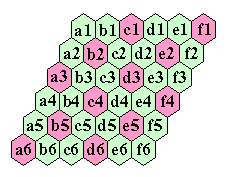| 36 Hole Rhombus Board |
[Preliminary
results] |
|
| Single Vacancy
to Single Survivor Problems |
|
| # |
Vacate |
Finish
at |
Length of Shortest Solution |
Number of Solutions |
Longest Sweep |
Longest Finishing Sweep |
Shortest Longest Sweep |
Number of Final Moves |
Comment |
| 1 |
(-2,3) |
a1 |
(-2,3) |
a1 |
14 (S) |
Unknown |
12? |
12 |
? |
? |
|
| 8 |
(-1,3) |
b1 |
(-1,3) |
b1 |
13 |
40 |
11 |
11 |
6 |
12 |
|
| 20 |
(1,3) |
d1 |
(1,3) |
d1 |
13 |
20 |
12 |
12 |
6 |
4 |
|
| 32 |
(2,3) |
e1 |
(2,3) |
e1 |
13 |
7 |
9 |
9 |
8 |
3 |
|
| 44 |
(0,2) |
c2 |
(0,2) |
c2 |
13 |
126 |
12 |
12 |
7 |
6 |
|
| 56 |
(1,2) |
d2 |
(1,2) |
d2 |
13 |
3 |
8 |
8 |
8 |
1 |
|
| 68 |
(0,1) |
c3 |
(0,1) |
c3 |
13 (S) |
5 |
9 |
9 |
8 |
9 |
13-move solution can finish from 4 corners |
| 75 |
(0,3) |
c1 |
(0,3) |
c1 |
14 |
Unknown |
13? |
13 |
? |
? |
|
| 87 |
(3,3) |
f1 |
(3,3) |
f1 |
14
(S) |
3347 |
13 |
13 |
4 |
180 |
|
| 96 |
(-1,2) |
b2 |
(-1,2) |
b2 |
14 (S) |
Unknown |
13? |
13 |
? |
? |
|
| 103 |
(2,2) |
e2 |
(2,2) |
e2 |
14 (S) |
Unknown |
12? |
12 |
? |
? |
|
| 112 |
(1,1) |
d3 |
(1,1) |
d3 |
13 (S) |
4 |
10 |
10 |
8 |
4 |
|
| ### |
(5,-7) |
f8 |
(2,-7) |
c8 |
|
|
|
|
|
|
|
| |
|
|
|
|
|
|
|
|
|
|
|
| Column
Definitions: |
|
|
|
|
|
|
|
|
| Length of
Shortest Solution |
This is the length of the shortest solution to
this problem, minimizing total moves |
| Number of
Solutions |
|
This is the number of unique solution
sequences, irregardless of move order and symmetry |
| Longest Sweep |
|
|
This is the longest sweep possible in any
minimal length solution [link to solution] |
| Longest
Finishing Sweep |
This is the longest sweep in the final move of
any minimal length solution [link] |
| Shortest
Longest Sweep |
There is no minimal length solution where all
sweeps are shorter than this number [link] |
| Number of Final
Moves |
|
This is the number of different finishing moves
(up to symmetry) |
| (S) Problem is
symmetric, multiple solutions counted as one |
|
|
|
| Solution
differences can be very subtle. |
|
|
|
|
|
|
|
|
|
|
|
|
|
|
|
|
|
|
|
|
|
|
|
|
|
|
|
|
|
|
|
|
|
|
|
|
|
|
|
|
|

